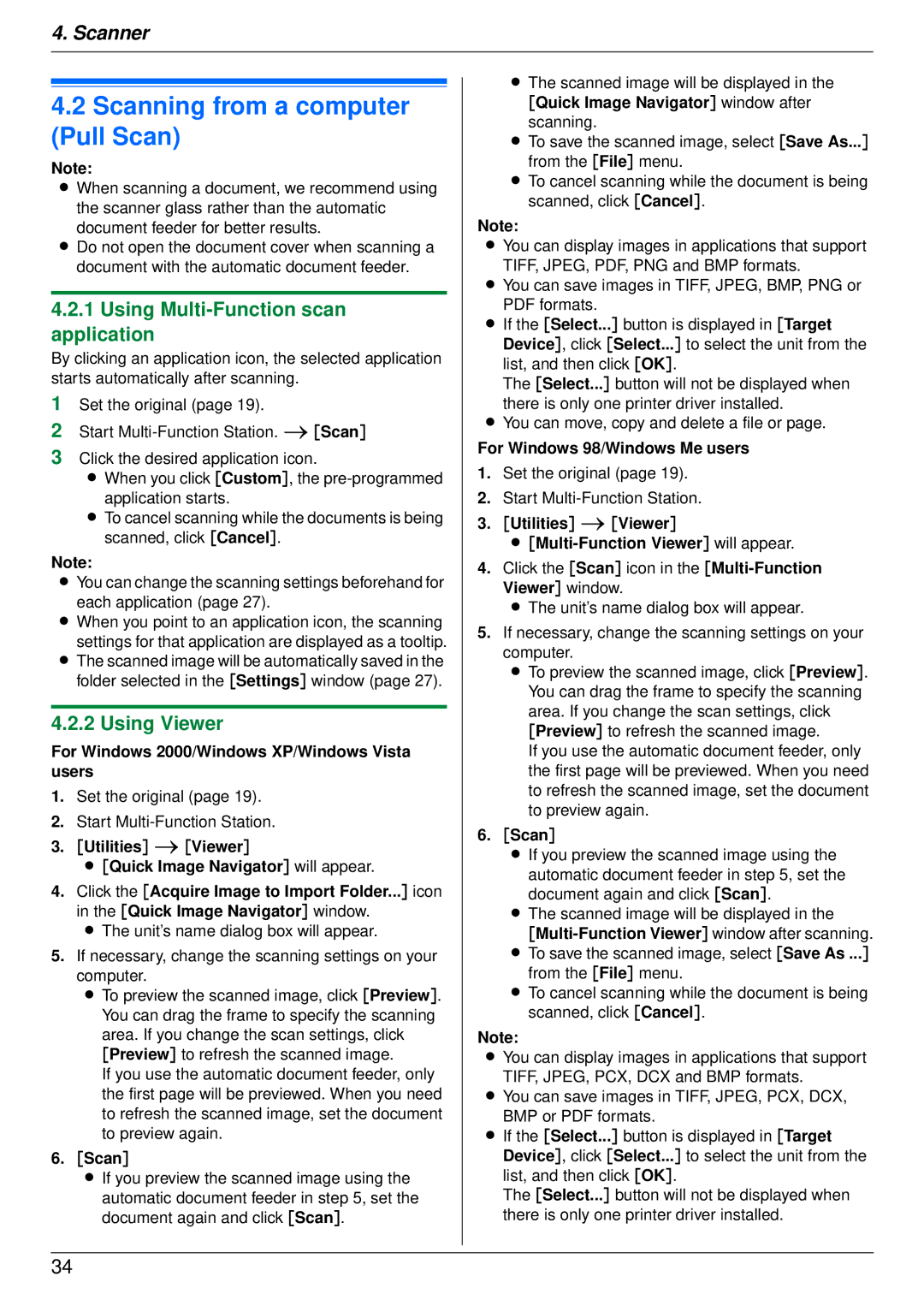
4. Scanner
4.2Scanning from a computer (Pull Scan)
Note:
LWhen scanning a document, we recommend using
the scanner glass rather than the automatic document feeder for better results.
LDo not open the document cover when scanning a document with the automatic document feeder.
4.2.1Using Multi-Function scan application
By clicking an application icon, the selected application starts automatically after scanning.
1Set the original (page 19).
2Start
3Click the desired application icon.
LWhen you click [Custom], the
LTo cancel scanning while the documents is being scanned, click [Cancel].
Note:
LYou can change the scanning settings beforehand for
each application (page 27).
LWhen you point to an application icon, the scanning
settings for that application are displayed as a tooltip.
LThe scanned image will be automatically saved in the folder selected in the [Settings] window (page 27).
4.2.2 Using Viewer
For Windows 2000/Windows XP/Windows Vista users
1.Set the original (page 19).
2.Start
3.[Utilities] i[Viewer]
L[Quick Image Navigator] will appear.
4.Click the [Acquire Image to Import Folder...] icon in the [Quick Image Navigator] window.
LThe unit’s name dialog box will appear.
5.If necessary, change the scanning settings on your computer.
LTo preview the scanned image, click [Preview]. You can drag the frame to specify the scanning area. If you change the scan settings, click [Preview] to refresh the scanned image.
If you use the automatic document feeder, only the first page will be previewed. When you need to refresh the scanned image, set the document to preview again.
6.[Scan]
LIf you preview the scanned image using the automatic document feeder in step 5, set the document again and click [Scan].
LThe scanned image will be displayed in the
[Quick Image Navigator] window after scanning.
LTo save the scanned image, select [Save As...]
from the [File] menu.
LTo cancel scanning while the document is being scanned, click [Cancel].
Note:
LYou can display images in applications that support
TIFF, JPEG, PDF, PNG and BMP formats.
LYou can save images in TIFF, JPEG, BMP, PNG or PDF formats.
LIf the [Select...] button is displayed in [Target Device], click [Select...] to select the unit from the list, and then click [OK].
The [Select...] button will not be displayed when there is only one printer driver installed.
LYou can move, copy and delete a file or page.
For Windows 98/Windows Me users
1.Set the original (page 19).
2.Start
3.[Utilities] i[Viewer]
L[Multi-Function Viewer] will appear.
4.Click the [Scan] icon in the
LThe unit’s name dialog box will appear.
5.If necessary, change the scanning settings on your computer.
LTo preview the scanned image, click [Preview]. You can drag the frame to specify the scanning area. If you change the scan settings, click [Preview] to refresh the scanned image.
If you use the automatic document feeder, only the first page will be previewed. When you need to refresh the scanned image, set the document to preview again.
6.[Scan]
LIf you preview the scanned image using the
automatic document feeder in step 5, set the document again and click [Scan].
LThe scanned image will be displayed in the
LTo save the scanned image, select [Save As ...] from the [File] menu.
LTo cancel scanning while the document is being scanned, click [Cancel].
Note:
LYou can display images in applications that support
TIFF, JPEG, PCX, DCX and BMP formats.
LYou can save images in TIFF, JPEG, PCX, DCX,
BMP or PDF formats.
LIf the [Select...] button is displayed in [Target Device], click [Select...] to select the unit from the list, and then click [OK].
The [Select...] button will not be displayed when there is only one printer driver installed.
34
